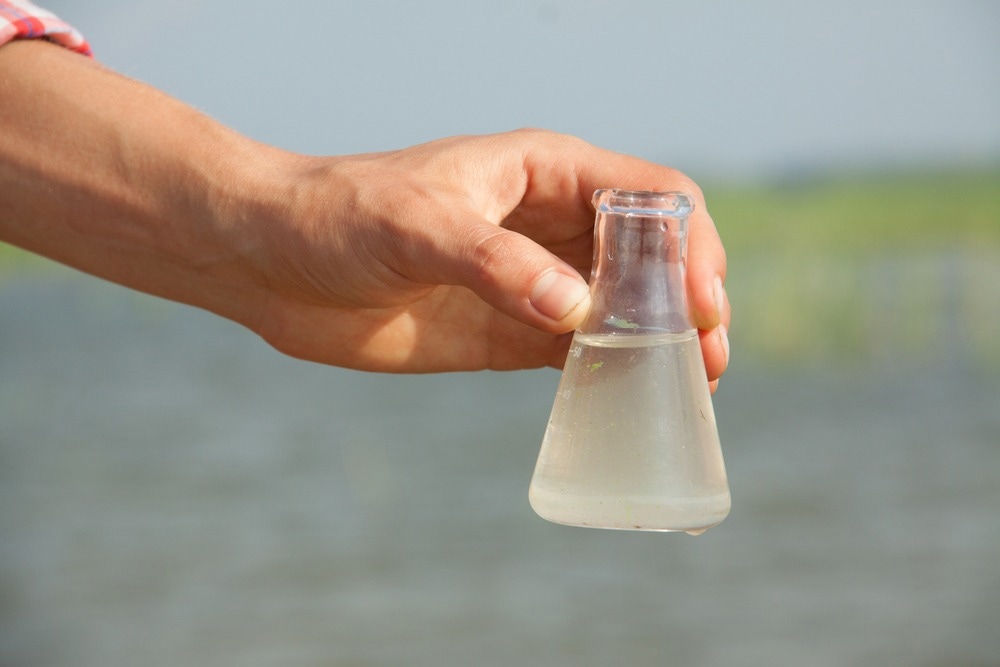The impact of breakdown and subsequent discharge in liquids have long been applied in various technological fields and industries. Discharge in water from electrical pulses is especially interesting because it produces chemically active organisms.
 Study: Optical Emission Spectroscopy of Underwater Spark Generated by Pulse High-Voltage Discharge with Gas Bubble Assistant. Image Credit: Merkushev Vasiliy/Shuttterstock.com
Study: Optical Emission Spectroscopy of Underwater Spark Generated by Pulse High-Voltage Discharge with Gas Bubble Assistant. Image Credit: Merkushev Vasiliy/Shuttterstock.com
A new experimental study published in Processes by a research group led by Professor Vit Jirasek from the Department of Pulse Plasma Systems, Institute of Plasma Physics of the Czech Academy of Sciences, investigated the effects of water absorption on the emission spectra using optical emission spectroscopy (OES).
The gas bubble volume in which the electric discharge is initiated significantly impacts spark characteristics. The underwater spark channel's plasma was observed to not correspond to a source of black-body radiation.
Dynamics of Underwater Discharges
Understanding the characteristics of underwater discharges caused by high-voltage electrical pulses is becoming increasingly beneficial. Related phenomena such as spark expansion in water, shockwave generation, the dynamics of the cavitation bubble created by the sparks, and UV radiation have been investigated extensively.
The pre-breakdown and spark phases are the two necessary stages in underwater discharge development. The beginning of the pre-breakdown phase is marked by the launch of the streamers and their subsequent spread.
The initiation may take place in microbubbles that are always present in the water or in a vapor bubble or cavity that has been created artificially. Joule heating, shockwaves, or gas injection are employed to develop bubbles artificially.
Chemically active species generated by discharges in water have many industrial uses. For example, these dischargers are used in applications such as:
- Clean industrial wastewater that contains chemical and organic pollutants
- Produce numerous particles, including neutrons
- Emit electromagnetic radiation of different wavelengths, including soft X-rays
- Source of UV radiation, ozone, and hydrogen peroxide
Optical Emission Spectroscopy (OES)
OES is a widely used method to analyze the optical spectrum produced by underwater discharges. Using electrical energy from a spark created between an electrode and a metal sample, OES raises the vaporized atoms to a high energy state within a region known as a "discharge plasma." Spectral lines produced by this method are analyzed to obtain information about the constituents of the plasma.
Overcoming OES Challenges
The strong water absorption in the visible spectral range inhibits OES measurements of sparks. The spark channel expands explosively upon initiation, making OES analysis challenging.
Professor Jirasek and colleagues devised a novel experimental set-up involving an injected gas bubble with special consideration to mitigate water absorption.
As elaborately described in their publication, the experiment demonstrated
light emission spectra of the underwater sparks without any water absorption. This study's methodology explains the distinction between discharges created directly in a liquid and discharges created in gas or vapor bubbles encircling a liquid.
Experimental Results
The optical spectrum constructed through OES displays several known features of hydrogen and oxygen. Within hydrogen, the spectral lines consistent with Hα, Hβ , Hγ, Hδ can be resolved.
Changes in controllable experimental variables correlate the spectral features acquired to the size of the injected bubble. For example, the H line shape changes with the size of the injected nitrogen bubble.
The observed behavior suggests that the smaller the amount of water that evaporates or decomposes, the smaller the pressure in the discharge channel, and consequently, the narrower and more pronounced the H line. The larger the injected bubble is in the breakdown moment, the shorter the path of the discharge in water, and the smaller the amount of evaporated or decomposed water. This leads to a broader H spectrum.
OES was used to analyze the plasma in an underwater spark discharge created between two-rod electrodes. Light absorption has a negative impact on optical spectra that are being collected.
An efficient OES measuring technique has been developed to avoid the detrimental effects of light absorption. The spark plasma spectrum data obtained was unaffected by the absorption effect.
The OES findings indicate that the plasma in underwater sparks lacks a black body source feature, and significantly widened line radiation may cause the dominant feature observed in the visible spectrum between 350 to 580 nm.
When the gas bubble size shrinks as the discharge progresses, the H line tends to broaden due to pressure increases in the spark channel.
References
Stelmashuk, Vitaliy, Vaclav Prukner, Karel Kolacek, Andrii Tuholukov, Petr Hoffer, Jaroslav Straus, Oleksandr Frolov, and Vit Jirasek. (2022) Optical Emission Spectroscopy of Underwater Spark Generated by Pulse High-Voltage Discharge with Gas Bubble Assistant. Processes 10, no. 8: 1474. https://www.mdpi.com/2227-9717/10/8/1474
Disclaimer: The views expressed here are those of the author expressed in their private capacity and do not necessarily represent the views of AZoM.com Limited T/A AZoNetwork the owner and operator of this website. This disclaimer forms part of the Terms and conditions of use of this website.